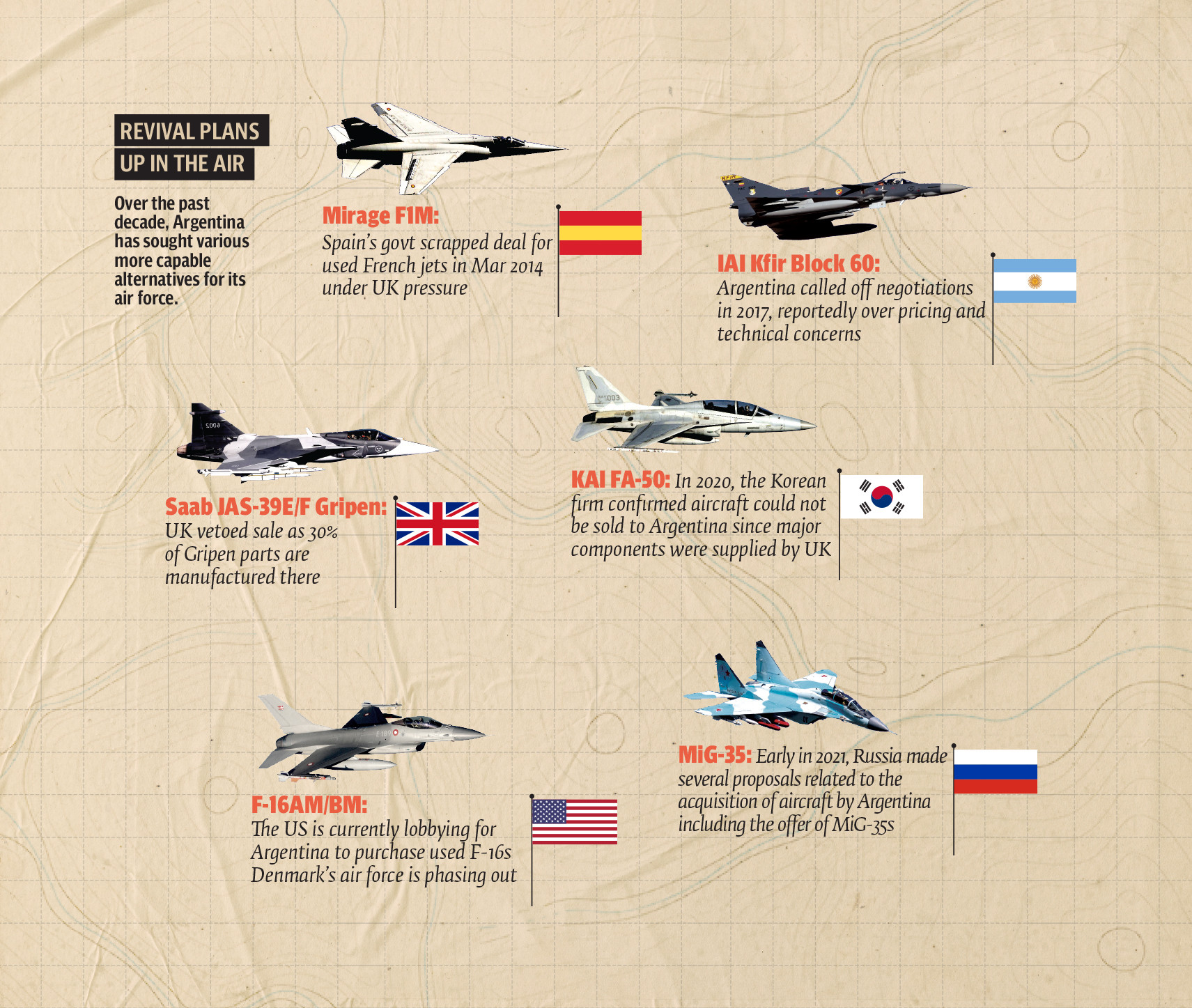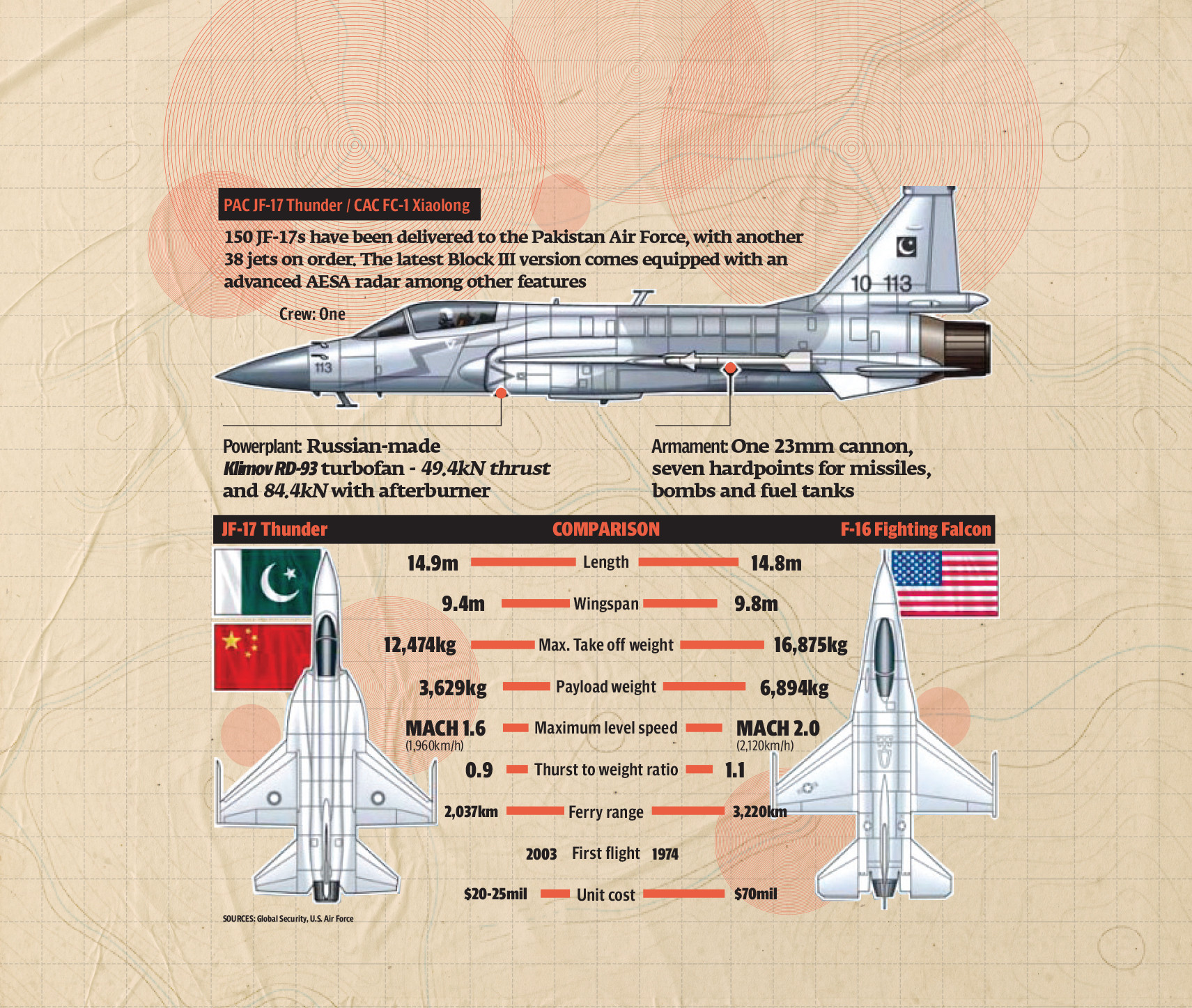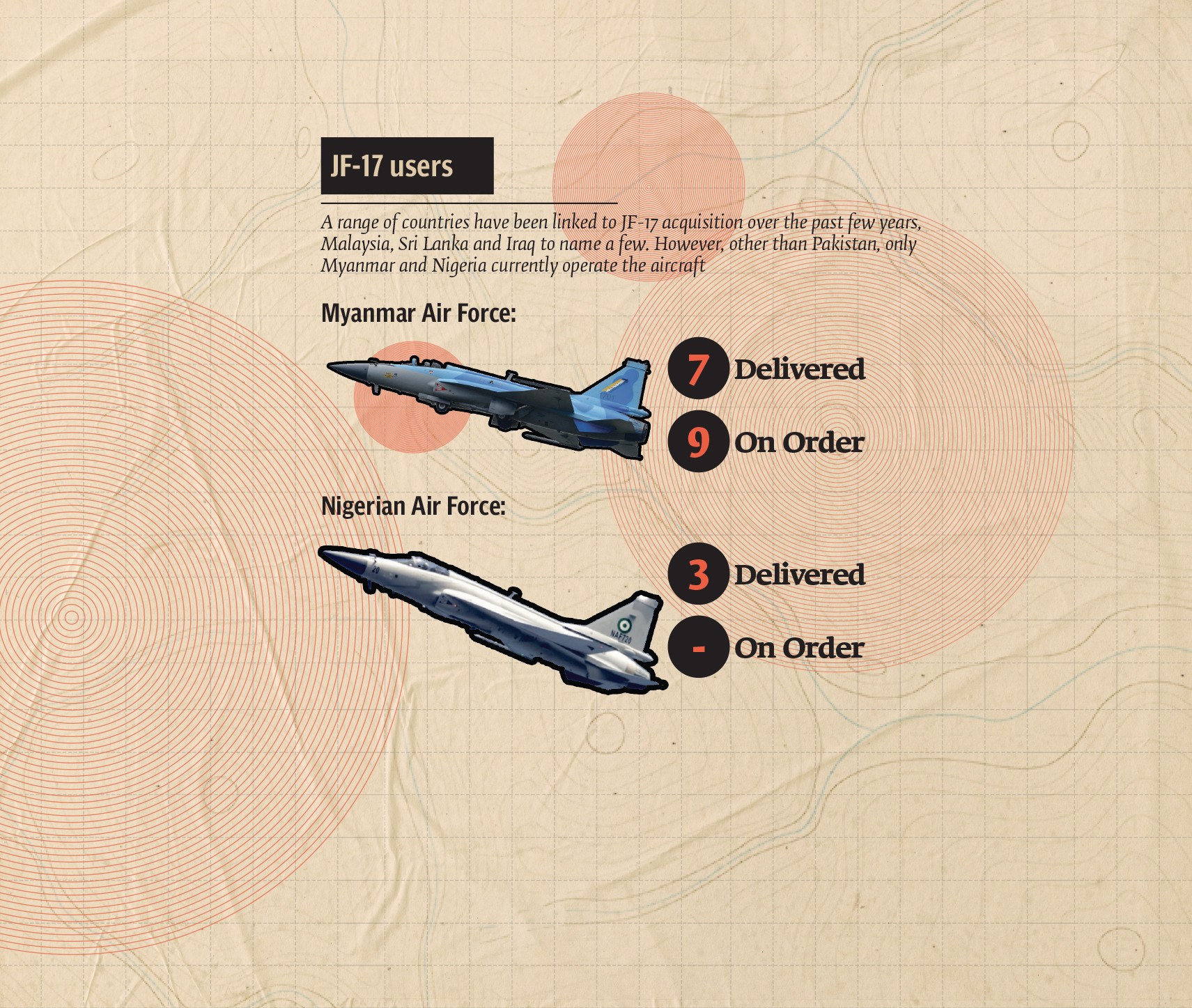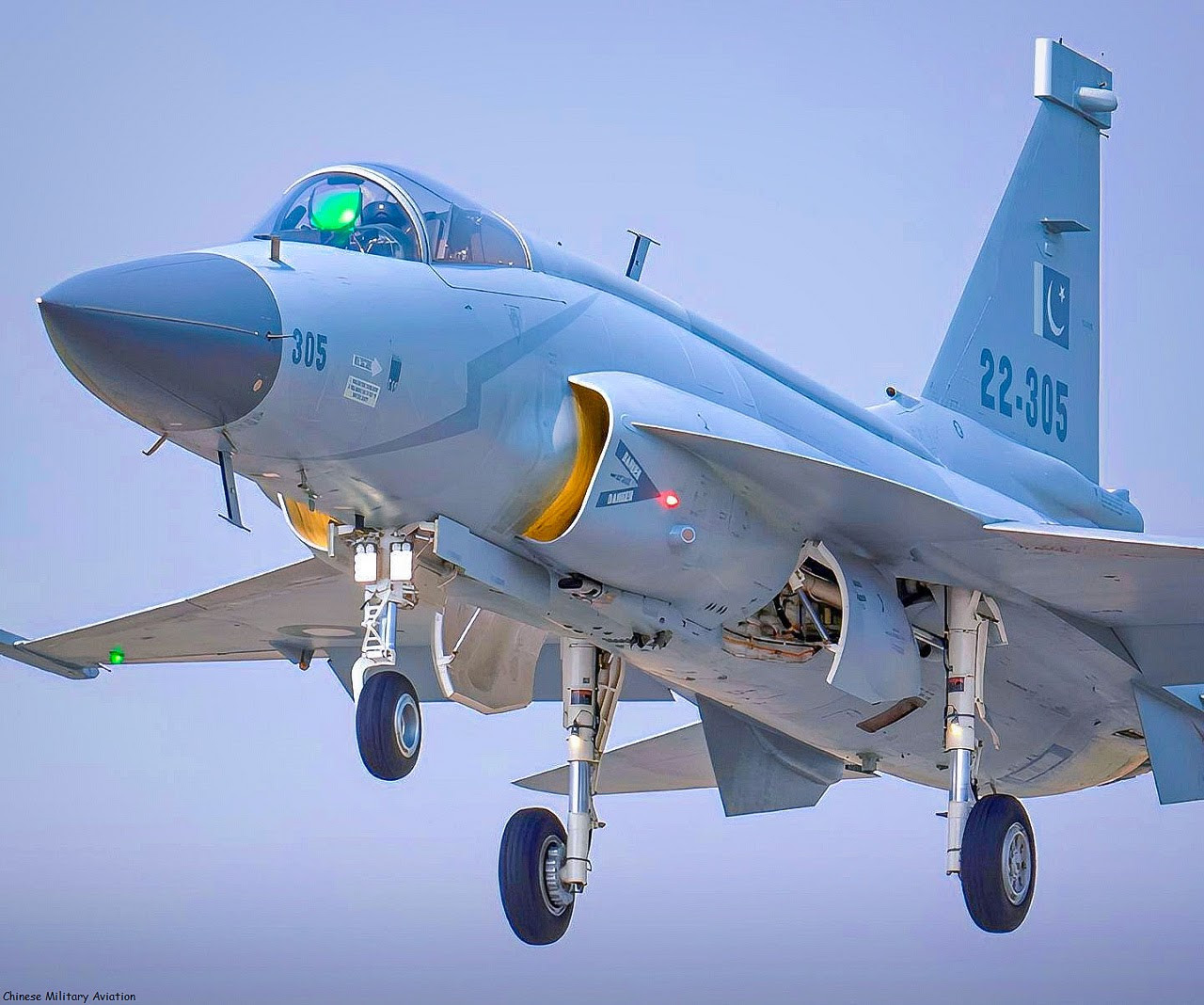When it comes to military hardware, nothing quite catches the ordinary person’s imagination like fighter jets. They are, in many ways, charismatic objects elevated often to being sources of national pride. This is doubly the case if the plane in question can be labelled to some degree as being indigenous.
In Pakistan, one needs not be an aviation enthusiast to develop at least some degree of fascination for fighter jets. From the Sabre’s that engaged in dogfights over Lahore in 1965 to the F-16s that have formed the tip of Pakistan Air Force’s spear for four decades, multiple types have won some iconic status.
The JF-17, if for no other reason than that Pakistan can claim it as its own, occupies similar status. So it’s no wonder that any report or rumour of sale becomes the subject of discussion and speculation.
Recently, some rumblings from the other side of the world have triggered such speculation. A country from South America with many parallels to ours – some superficial and some tragic – has expressed interest in the jets for perhaps the same reasons that led Pakistan to develop them.
Cash-strapped, embargo stricken Argentina is the latest country to express a desire to purchase the JF-17 fighter. If the sale goes through, it could perhaps become the most significant operator of the type outside of Pakistan.
But is there some substance to the development or are we making a mountain out of a molehill? The Express Tribune turned to prominent international and local defence experts to unpack what Argentina, China and Pakistan could gain from such a deal, and whether its even likely to go through.
 Design: Mohsin Alam
Design: Mohsin Alam
Air force woes
To unpack the current state of Argentina’s air force and wider military dynamics in Latin America, The Express Tribune reached out to Dr Carlos Solar, a senior research fellow in the International Security Studies team at RUSI. He shared that the current state of all three Argentinian armed services had put them in a state of doubt about their capacity to deploy forces.
“If you think about the current state of Argentine military… it was once heavily armed in the 70s and 80s given geopolitics of the time,” said Dr Solar, whose research is focused on security dynamics in the Americas, notably on military, human security, and international relations issues that connect with the West. “[But now] the navy is in a dire situation… as evident by the accident that led to the sinking of a submarine. [And] if you look at IISS military balance documents, all Argentina has are around 20 American-made A-4 Hawks and 10 training planes and other non-fighter jets.”
To draw a contrast, Dr Solar compared Argentina’s military to that of its neighbour Chile’s, which he said the former was almost days if not hours away from declaring war upon at one point in the late 70s. “Both Argentina and Chile were dictatorships at the time and generals [on both sides] put a lot of effort into maintaining their respective armed forces.”
The present situation between the two air forces is starkly different, said Dr Solar, with Chile able to obtain F-16s as the mainstay of its air force. The woes of Argentina’s air force, the RUSI analyst explained were down to two developments. “Of course, Chile didn't go to war with the UK. So Argentina has a UK arms embargo that is severely cutting any possibilities for them to buy new equipment without going through the censorship of whatever the UK government might say,” he said, referring to the war over the Falklands/Malvinas in the early 80s.
But another factor also severely hampered Argentina’s ability to replenish and maintain a capable air force that was once widely respected in the region and the rest of the world.
“The armed forces don't have that much of a lobby power in Argentina, unlike Brazil – where we saw them helping the government with Jair Bolsonaro – or Colombia – where they have been fighting for 60 years,” Dr Solar shared. The armed forces of Chile, on the other hand, did and when the country democratised, were able to keep military corporate privileges that allowed the country to reinvest in new arms and equipment. “Argentina was on the other end of the spectrum. Civilian authorities didn't budget for their armed forces at all.”
The path to Thunder
Despite meagre means, Argentina’s air force has explored various options to acquire more capable jets for its air force, either new or second-hand. In the early 2010s, the country set its sights on French-built Mirage F1M fighters that Spain’s air force was phasing out. But under UK pressure, Spain’s government scrapped the deal in March 2014 and private operators have since picked up the fighters in question.
Another jet the Argentinians looked at was a highly modified version of the Israeli Kfir jet, which Colombia still uses and Ecuador once used. Negotiations were abruptly called off with no official word in 2017, but reports cited price and technical concerns regarding the fighter’s aging engine and other systems.
The Swedish Gripen, claimed by its manufacturer to be the cheapest fighter to operate, was another that drew Argentina’s attention. But even as neighbouring South American powerhouse Brazil inked a deal to locally produce the fighter, the UK blocked any sale to Argentina by not allowing the export of British subsystems used in the plane.
A sale of Korean FA-50 fighter-trainer fell to a similar fate. “In 2017 Argentina tried to buy FA-50s from South Korea which fell through due to the UK arms embargo as it used components made in the UK that were subject to the embargo,” said Dr Solar. “Since they’ve tried before unsuccessfully with Western partner … I think the Argentinian government, irrespective of colour, left or right, is undergoing a process of saying we might never buy anything from the West and our only vendors will come from the East.”
 Design: Mohsin Alam
Design: Mohsin Alam
The case for JF-17s
Speaking to The Express Tribune, Air Commodore (retd) Jamal Hussein said that one of the biggest selling points for the JF-17 is that is around 50 per cent cheaper to buy and operate than any other fighter aircraft that offers similar capability. “The unit cost of the latest Block 3 version of the JF-17 is only around $50 million, and this version comes with an AESA radar,” he pointed out.
He explained that there was a time when the most important thing while evaluating a fighter aircraft was how fast or manoeuvrable it was. But now, the question of how good a radar it comes with and what the range of missiles it can be armed with is more important.
“There was a time when China was far behind when it came to avionics. This was the case when the Pakistan Air Force acquired the Chinese-made F-6 fighters,” Hussein shared. “Now the situation is completely different. Chinese radars, avionics and other sub-components have caught up. They still may not be as good as the Americans, but they offer competitive capability for a much lower price point.”
He said that on paper, for instance the PL-15 missile that the JF-17 Block 3 can be armed with has a much longer range than the US-made AMRAAM and French MICA missiles. The latter is what the India’s newly acquired Rafale fighters are armed with.
“For an offensive operation, the JF-17 is not ideal. But if you’re looking for the air defence factor and are short on cash, the JF-17 is the best buy,” he observed. “For air combat, the JF-17 is more than capable and as an air defence fighter, it would suit an air force like Argentina’s perfectly. The only problem I foresee with this acquisition is how much influence the US can bring to bear.”
Sharing insight on China’s increasing advancements in the high-end military aviation sector, Lukas Fiala, who researches China’s defence industry, military strategy and emerging security relationships with countries in the Global South, acknowledged that the country is knocking on the doors of major defence firms in the West. “They're probably overall not quite there yet but broadly speaking, the relative progress that China has made is very impressive. To deny that progress would be to distort the picture a little bit,” he said.
Fiala, who is also the Project Coordinator of China Foresight, a China-focused research programme at the LSE’s IDEAS foreign policy think-tank, viewed the JF-17 as an interesting project. “It's one of the few defense industrial offset projects that China has and it has been successful over the long term. The latest block is very important and shows that China is increasingly able to develop fairly advanced and also very capable weaponry.”
According to Fiala, if China is able to frame the JF-17 as a more budget friendly option, then that obviously will increase the opinion of the aircraft. “China usually does this in either one of two ways: Either they offer a state-to-state loan for the procurement of the aircraft, and then sometimes that loan is paid back by commodities. The other option would be to offer buyers' credits, which AVIC has done previously in southern Africa. [It’s] essentially a firm level brand of a loan that a government could pay back.”
Given that AVIC is a state-to-state enterprise and given that China has obviously the largest sovereign credit across the developing world, China is sort of in a unique position because it has these budgetary arrangements that it can actually offer to countries, Fiala said.
Comparing the possible sale to the used F-16 route the US is pressuring Buenos Aires towards, he highlighted the downside of the latter for Argentine military planners. “If Argentina were to procure F-16s, what’s the downside of that? The UK and US are very close allies at the end of the day and the US can either limit the ways in which those jets can be used or exert influence through maintenance, repair, and operations (MRO). The UK's position is fairly consistent it that it obviously wants to embargo Argentinean purchases that enhance its military capacity.”
Given its current challenges, Fiala said any aircraft model would be useful for the Argentine Air Force. “While the JF-17 may not be as welcome a choice as F-16s, it does come with fairly advanced and capable missiles.”
Lastly, he drew attention to the defence industrial component. “China could obviously offer, some form of a defense industrial offset to Argentina whereby parts of the plane are manufactured locally or the platform is assembled locally. That may take care of any hesitancy on the Argentine side,” he said. “China could also offer some form of local capacity transfer, to make sure that local engineers and local technicians actually know how the plane works, and how to assemble the plane, maintain the plane, etc.”
 Design: Mohsin Alam
Design: Mohsin Alam
The case against JF-17s
Despite seeming the best fit its air force on paper, Dr Solar said there is severe pressure for the Argentinian government not to buy any Chinese related military equipment. “A potential sale of JF-17s will clearly be a game changer … not just for Argentina but the entire Southern world,” he said. “It would put major military equipment from China in Latin America, which is seen by Western powers, the UK and US especially, with a lot of scepticism.”
The RUSI analyst pointed out that defence diplomacy moves on a different track from political diplomacy. “In terms of military to military diplomacy, Argentinians have been doing quite well in terms of being very clear. They’re very close to Chile, which already has F-16s. From a strategic point of view, if the Argentinians and Chileans have F-16s, basically the whole Southern corner of Latin America can be policed with interoperable planes. It makes a lot of sense for Argentina to have Western equipment, even if it's just one submarine, two frigates, or a handful of F-16s, because it creates an interoperable force that is larger and international.”
However, a sale of JF-17s will place Argentina in a clear long-term relationship with China, because of the commitment to service them. The Chinese may even use it as an entry point for military exercises with and in Argentina. “It's the long-term relationship that worries the US and all its partners,” he said.
Given the role of bilateral exercises between Chile and Argentina in bringing sustainable peace and friendship to two nations that were once on verge of war, the former might also view Argentina switching sides to China with some scepticism, noted Dr Solar. “It might even affect that peace, which was created with some indirect help from the US and other Western powers. Basically with such a purchase, Argentina is saying goodbye to those relationships.”
The other issue potentially blocking the sale is purely economic. “Around $640 million for a country that needs that kind of money for social policy as its people suffer under more than 100% inflation. The defence ministry will defend any investment in the military because it’s their parcel. But it will be seen as a big issue given that the same money could go into health or the country’s poorer regions,” Dr Solar explained.
F-16 alternative and the UK question
While Argentina and China explore a possible JF-17 sale, the United States has sought to facilitate an alternative. Used F-16s that Denmark’s air force is looking to phase out in favour of fifth generation F-35s have been offered to Argentina, although the UK continues to lobby against such a sale.
For Dr Solar and Fiala, the UK’s stance posed the million-dollar question when it came to whether Argentina will buy JF-17s or F-16s for its air force.
According to the latter, broadly speaking, it would not be in the UK's interest to have JF17s in Argentina. “If the UK believes that China is a systemic challenge and that Beijing uses all levels of state power to advance its agenda, it would be more in the interest of the UK to have the F-16s in Argentina, just because there'd be some form of accountability,” Fiala said.
With the sort of capabilities the JF-17 may provide Argentina, Dr Solar believed the country’s air force would be able to extend its reach to the Malvinas/Falklands territory “This would force the UK to rethink its military presence in the South Atlantic. For the UK, servicing the Falklands is quite expensive already. Imagine if it has to double its military footprint.”
So why would the UK not want Argentina to have Western equipment so that can be easily controlled by either them or the Americans? Dr Solar noted that for the US, it definitely makes a lot of sense to have Argentina on their side rather than allowing them to fall into the Chinese hand. “But I think the UK strategically sees that the Argentinians are still pushing the issue of territorial sovereignty over the South Atlantic. That's the keystone here,” he observed.
Although Argentina presently has a good relationship with the UK and signed a treaty where both parties agreed to a kind of status quo towards the reclamation for the Malvinas/Falklands, Dr Solar noted that it would be political suicide for an Argentine government, irrespective of colour, to give up its stance on the islands. “That raises alerts for the UK and is a major obstacle for the British government to say we're going to let the Argentinians rearm themselves, even if it's with Western military equipment.”
The RUSI analyst shared that that is probably why the US is on the wall about supplying Argentina with F-16s as well. “Politically once it goes outside the reach of the military and up to elected politicians in Congress or the White House, they would say what should we prioritise? Our partnership with UK, with whom we’re putting all our effort in the fight against the Russians and to contain China? Or do we turn our back on the British and see how it plays?”
 Design: Mohsin Alam
Design: Mohsin Alam
Election year tango
Dr Solar tried to put all the narratives around Argentina’s defence in the context of elections later this year in the Latin American nation. “We are now in an electoral year, with a presidential election scheduled in December, so all of these narratives are clearly pointing towards winning an extra point towards the end of the race,” he said, pointing out that the government is picking on all the agendas that it can. “It was winning the World Cup one day, claiming sovereignty over the Falklands and so on.”
According to him, the JF-17 links only got into the news quite recently because Argentina’s Defence Minister Jorge Taiana travelled to China and said his country finally had an agreement for the jets. “Around $20 million, under that agreement, would be used to build infrastructure needed for the fighter planes and that sent a signal that Argentina would be able keep them airworthy. Currently, the aircraft the Argentine air force operates have severe limitations… the A-4s, for instance fly once a year for the Argentine national day and that's it.”
“Announcing this massive military procurement, which will keep your military audience quite happy… there are political signs being sent with this potential purchase,” he explained. But this sort of signalling, according to Dr Solar, also is responsible for apprehension in London. “I tend to believe that there's concern in the UK on whether Argentina will definitely turn into a more anti-Western, anti-UK kind of like country, irrespective of colour.”
Chinese foothold
Dr Solar noted that Argentina already has some older technology-based engagement with China. “Take the case of the 16-storey-high military-run space antenna in Patagonia. That project triggered a lot of questions – where did the money come from, how much did China invest, who’s got accountability, etc. Argentinian Congress has kept total secrecy on that move. There are a lot of voices within the UK and the US that have raised concern,” he said.
He also explained that there is a spectre of non-alignment in the region, which plays significantly in terms of all these wars in other parts of the world and geopolitics. “Latin American nations say these are not a matter for Latin America, but the US and UK are sending a signal that they better reassess that idea.”
But although there is Chinese military equipment in the region right now, it so far has not enough for Americans to see it as a game-changer. “They have been mostly donations of very small numbers of equipment to countries like Bolivia, Ecuador, Nicaragua and Venezuela, which have moved away from the American side.”
According to Dr Solar, Latin American militaries usually buy technologies that are either second hand or not top of the line. But Argentina’s JF-17 procurement could also trigger an arms race by providing them with some top-of-the-range technologies.
“China basically offers platforms that a nation with limited money and needs can fit with what it requires and can afford. You don't need as much equipment to patrol your borders for challenges like potentially illegal fishing and the Chinese know this,” he said. By selling new technologies, Dr Solar said China would be sending a message that their willing to share the results of the huge technological jump they’ve made and that they can be reliable partners.
“The Chinese also play the trade and investments card, which is quite big in regions like ours,” he added. “So I can see why countries that are thinking about saving costs from expensive technologies could fall in the hands of the Chinese.”
For Argentina, the relationship with the United States has been good if seen in terms of military-to-military diplomacy only, Dr Solar said. “The military on both sides have been able to navigate the waters even when politicians stir the pot. Latin America is also a region that currently in peace. There's no reason why the US could have pushed Argentina out of its sphere.”
But any sale that Argentina agrees to will send a huge signal to the rest of the region that there's a clear separation from this historic US-Latin America military-to-military relationship, he added.

What’s in it for China (and perhaps Pakistan)?
For Fiala, any sale of JF-17 to Argentina would definitely be an inflection point for China's success in the global defence industry, for starters. “I think China has been able to move up with the value chain over the last 10 to 15 years in defence equipment more broadly and in aerospace particularly.”
And that, he said, has happened mostly due to targeted reform of China's defence industry that was led by the government starting from the mid 90s but really accelerated in the mid 2000s. “It then further accelerated under Xi Jinping. As we see from programmes such as the J-20 stealth fighter and even the [fourth generation] J-10, China has been able to not only adapt Russian equipment, but increasingly so innovate the top of these legacy foundations.”
Fiala also imagined that a host of Latin American governments are interested in diversifying their diplomatic relationships, which is particularly evident in the case of responses to the Ukraine war from the region. Whether through defence deals or not, it is easy to conclude that is an opportunity China would want to seize.
But while there’s always a major political component to defence deals, Fiala pointed out that ultimately the main agents are the companies that are trying to access these markets. “They do have to make a profit, right? For them, obviously, Latin America would be, if the opportunity presents itself, a welcome market.”
So where would Pakistan stand, if Argentina does acquire JF-17s? Discussing this question, Wing Commander (retd) Naseem Ahmed highlighted a unique facet of the JF-17 programme. According to him, while the Pakistan and China share the coproduction of the jet, its global marketing was carried out independently by both nations. “But despite this, if a sales pitch to another nation, whether by Pakistan or China is successful, both nations participate in the production of the order.”
“Even if Argentina is negotiating only with China for the purchase of JF-17s, this is a very good thing for Pakistan,” added Air Commodore (retd) Jamal Hussein. “While the JF-17’s engine comes from Russia and other major components like the radar are from China, most of the actual manufacture of the fighter jet takes place in Kamra in Pakistan,” he said. “In terms of cost, Pakistan accounts for 10 to 40 per cent of the JF-17.”
Even so, Wing Commander Naseem, a final sale would depend on how much influence the US has on the Argentine government, and how much China would be able to counter it and the Argentines able to resist it.
